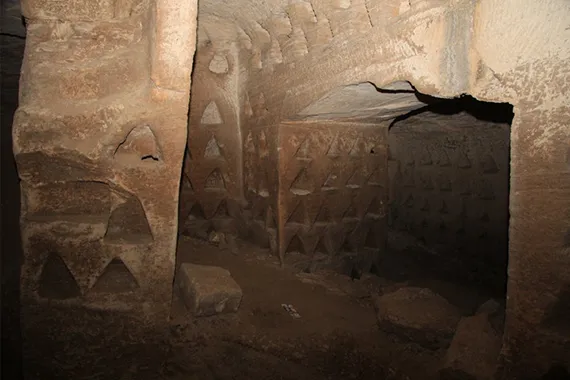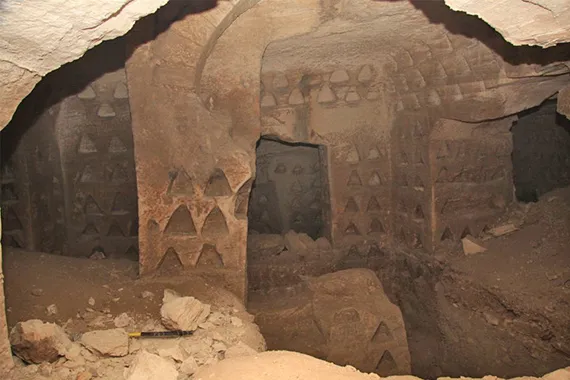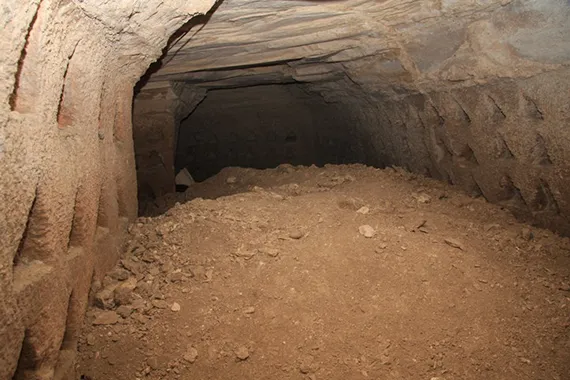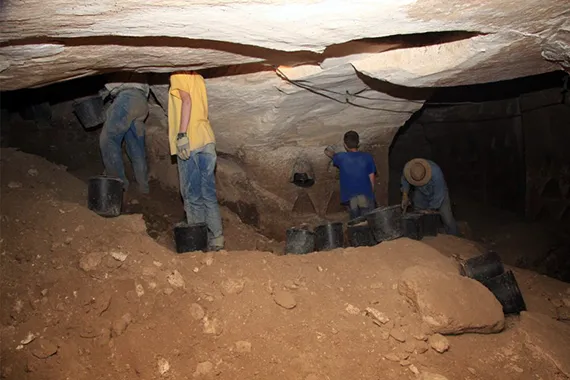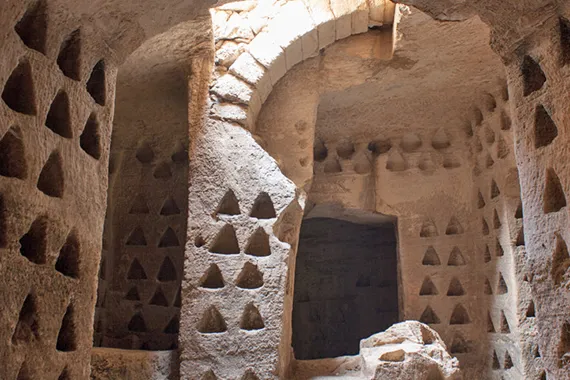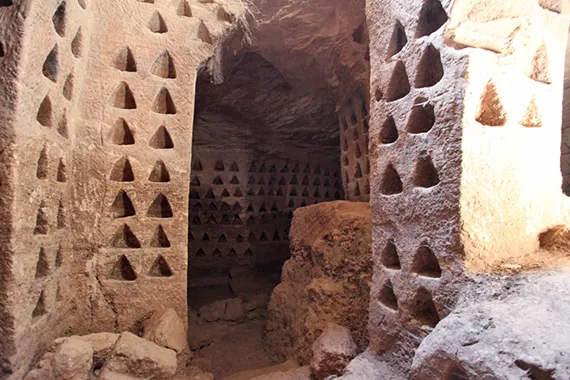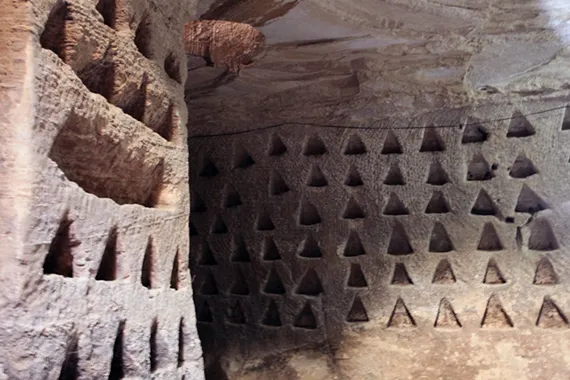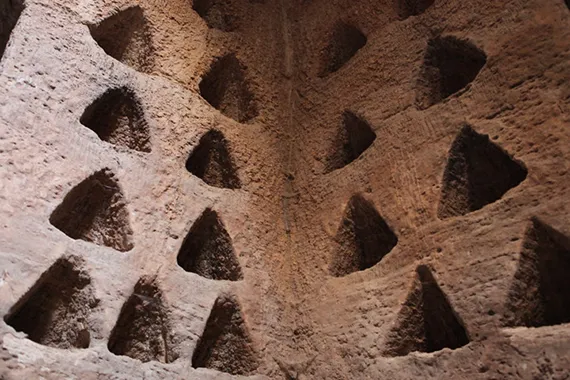
Large Columbarium
The largest columbarium discovered thus far at the site is located northwest of the oil press. Like the oil press, it was discovered by accident. While exploring the site, we came across a tunnel opening—another hiding tunnel from the Jewish Revolts—that twisted its way narrowly for quite a while in pitch darkness and subsequently led to the columbarium.
This huge complex was entirely hewn out of the soft limestone and comprises a central chamber separated from the surrounding chambers by arched openings. All but the western chamber had dovecotes. The columbarium contains around 1100 triangular niches that would house about 2200 doves.
Four deep circular hewn shafts were installed to let in light and air, as well as to allow the doves to come and go as they pleased. The shafts also featured small niches that enabled workers to climb up and down. When the columbarium went out of use, the shafts were sealed by massive stone slabs.
At some undetermined date, after the columbarium was no longer in use, a bell-shaped water cistern was carved in its southeastern corner. The builders must not have known of the columbarium’s existence, since they inadvertently broke through its northeastern wall, rendering the cistern only as a quarry. Another hiding tunnel, though blocked, is seen in the cistern’s southwestern wall, another project for future excavation seasons. A number of well-worn hewn steps descended from the shaft to a massive square pier with dove niches on each side. The steps appeared to have continued their descent by means of an arch that had long been dismantled, but whose traces can still be seen on the pier’s eastern face.
The dismantled arch apparently carried the steps eastward to another pier, preserved to a height of 7 feet, and from there the steps turned north, reaching the original columbarium floor. The arch was installed upon the columbarium’s completion; it supported the stone slabs above it that sealed the entrance, preventing the massive exodus of doves. From then on, the above-mentioned shafts were used as entrances, since at any time they could be blocked with metal grills.
At some later point, perhaps when the columbarium was still in use, the floor was significantly lowered by about 6.5 feet, leaving a crude block of stone featuring five hewn steps that descended to the floor. The hewn bedrock floor of this central chamber was lowered in several different spots, creating several “steps” of various heights, perhaps a small quarry of sorts. A few “incisions” into the rock are also seen, and were most likely preparation for the removal of a stone slab.
The team discovered an additional entrance way into the columbarium. Excavation of the area exposed a stepped passageway that led into an entrance room of sorts. Their work revealed that the entrance room was originally physically separate from the columbarium itself and served as a modest oil press. The oil press, dating to the Hellenistic period, was entirely rock-hewn and features one crushing basin and a few settling pits. The above-mentioned hiding tunnel broke through its southern wall. At some point, the floor of this entrance room collapsed—which was what had erroneously led us to at first believe that it and the columbarium comprised one unit.
The Spring 2009 season was the first in which the team utilized a portable conveyor belt system to excavate the columbarium. Until this point, earth and debris were removed solely via bucket chains—a difficult and inefficient process given the distance between the heart of the columbarium and the entrance. A Mamluk oil lamp and an Islamic bronze bell were found among the large amount of pottery carried out by the conveyor.
Upon reaching the bedrock of the columbarium what appeared to be a hole covered with plaster. Believing that it would lead to hidden treasure, a film crew was invited to witness the breaking through into the sealed chamber. Chiseling out the plaster produced about 10-foot tunnel that obviously had not been used in 2000 years. Entering through the tunnel we received surprise . . . another columbarium. That columbarium remains unexcavated. The question remains, why are there so many columbaria at Beit Lehi? Finds of particular note from this area include a Hellenistic arrowhead, possibly a remnant from the Hasmonean conquest of the region in the second century BC, numerous coins and a pottery shard inscribed with the Greek letter Alpha (A) and Omega (ω) flanking a cross, signifying the verse “I am the Beginning and the End” from the Book of Revelation (1:8, 21:6, 22:13). The latter attests to the Christian nature of the site during the Byzantine period.
Video
Video Transcript
The Large Columbarium is one of nine columbaria we have uncovered at the site of Beit Lehi so far. A columbarium is a dovecote, a place where they used to grow pigeons, or turtle doves, more correctly. The large columbarium has 1100 niches where a couple of birds used to nest. This is one of the biggest columbaria, if not the biggest columbarium, ever found in the land of Israel, which makes it the largest in the world. It was founded in the 3rd century B.C.E. and used until the late Byzantine period in the sixth century C.E., until an earthquake damaged it, which means that almost more than 800 years it was in use.
Virtual Tour
The virtual tour for this location works on your computer web browser as well as a tablet or a phone. Best of all, it works on your headset. For instructions using an Oculus Quest, please see our virtual visit page.
Image Gallery
